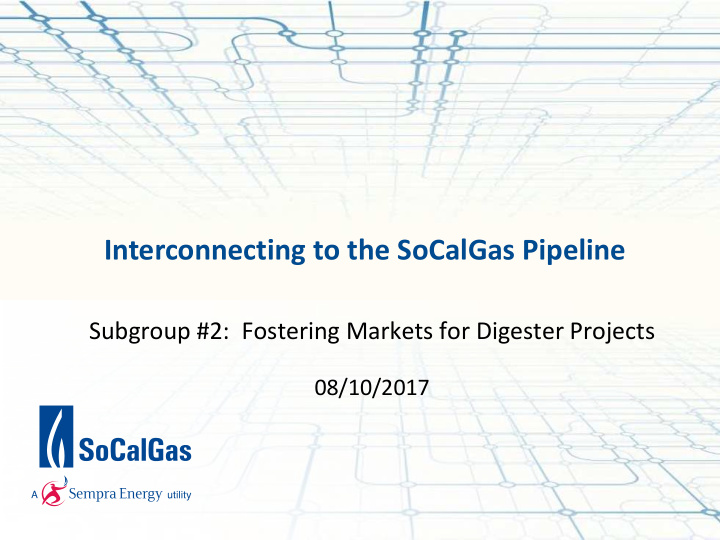



Interconnecting to the SoCalGas Pipeline Subgroup #2: Fostering Markets for Digester Projects 08/10/2017
Interconnection: Overview of Components and Costs Two Primary Components of the Term “Interconnection” Customer Pipeline “Pipeline Extension” Utility Pipeline “Point of Receipt” “Interconnection” = “Point of Receipt” + “Pipeline Extension” 2
What is the “Point of Receipt” Component of the Interconnection? Primary Function of Point of Receipt 1. Monitor gas quality to ensure it meets SoCalGas Rule 30 Gas Quality Specifications (e.g. CO 2 , O 2 , total inerts, heating value, H 2 S) 2. Prevent non-compliant gas from entering the utility pipeline network should the monitored Rule 30 parameters not be met 3. Meter and odorize the volume of RNG put into the utility pipeline network Estimated Cost for Point of Receipt • Estimated at ~$1.1 to 1.7 million (for delivery volumes ranging from 1 MMscfd to 10 MMscfd)* • Point of Receipt cost includes 22% Income Tax Component of Contributions and Advances (ITCCA). ITCCA Increases to 24% in 2018, 27% in 2019 and 35% starting in 2020 - pursuant to the Protecting Americans from Tax Hikes Act of 2015 3
What is the “Pipeline Extension” Component of the Interconnection? » Pipeline extension is the pipe installed from the outlet of the Point of Receipt to the nearest utility pipeline having the capacity to accept the interconnector volume of RNG » Majority of the pipelines in streets are distribution lines with limited takeaway capability to accept interconnector gas during summer months (particularly in the early a.m. hours) ▪ May result in high pipeline extension costs because the nearest pipeline having the capacity is miles away Illustration Nearest SoCalGas pipeline to Point of Receipt (e.g. 500 feet away) Nearest SoCalGas but doesn’t have the pipeline that has the capacity takeaway capacity to accept supply (e.g. - 1.5 miles away) Pipeline Extension Point of Receipt 4
Five Step Approach to Interconnecting to the SoCalGas Pipeline System 5
Step 1: High Level Utility Pipeline Assessment • SoCalGas has an interactive webpage where the user can type in an address and it will show the nearest high pressure pipeline(s). The map does not show all high-pressure pipelines. http://www.socalgas.com/safety/pi peline-maps/ • There is also a “National Pipeline Mapping System” that shows high pressure pipelines across the United States https://www.npms.phmsa.dot.gov/ • Contact the SoCalGas Market Development Team Email: jlucas@semprautilities.com Reminder: Existence of a gas line does not mean it has the necessary capacity! 6
Step 2: SoCalGas Rule 39 Interconnection “Capacity Study” (Funded by Interconnector) Interconnection Capacity Study - determines SoCalGas’ takeaway capability to accept interconnector gas (and estimated cost to expand if necessary) Keep in mind: • Detail is important (e.g. – precise project location, volumes are critical) • Adjacent line to project doesn’t guarantee injection acceptance • It is very costly to install pipelines in the public right of way Nearest SoCalGas Pipeline Extension pipeline that has the takeaway capacity The Capacity Study provides: to accept supply Biogas Producer 1) approximate pipeline extension length Location = X and very high level cost to install Biomethane Volume = Y 2) location of the pipeline having take away capacity Based on the high level results of Capacity Study, is it economically viable to inject RNG into the utility pipeline? 7
Steps 3 & 4: SoCalGas Rule 39 Interconnection “Engineering Studies” (Funded by Interconnector) Step 3: Preliminary Engineering Study (PES) - more detailed study which includes cost estimate for Gas Quality Monitoring and Measurement Facilities (Point of Receipt) Nearest SoCalGas pipeline that has the takeaway capacity to accept supply Pipeline extension length of X feet with a Point of Receipt with Biogas Producer more refined cost estimate of $X estimated cost of $X Based on the results of Step 3, is it economically viable to inject RNG into the utility pipeline? Step 4: Detailed Engineering Study (DES) - describes all costs of construction, develop complete engineering construction drawings, and prepare all permit applications 8
Step 5: SoCalGas Interconnection Authorization, Funding and Construction ▪ Authorization and Funding of interconnection work ▪ CPUC Biomethane Monetary Incentive ▪ Interconnector to work with utility and follow program guidelines ▪ Construction and Reconciliation of Cost ▪ Interconnector is responsible for 100% of actual costs A Few Keys to Ensure a Smooth Process ▪ Involve SoCalGas as early as possible, generally at least 18-24 months in advance of desired in service date ▪ Recommend reviewing various Rule 39 Agreements (available on socalgas.com) early on in the process ▪ Be ready to fund invoices for various Rule 39 Agreements 9
Biomethane Interconnection Incentive Statewide Program Cap of $40 million, Ending on 12/31/21 All other interconnection projects Interconnection project with 3 (e.g. landfill, wastewater, landfill or more dairies in close diverted organics, 1-2 dairies) proximity Incentive of 50% of Incentive of 50% of eligible costs with eligible costs with $5 Million Cap $3 Million Cap Eligible costs include Eligible costs include Compression equipment Biogas collection lines for product gas Compression equipment Utility Point of Receipt for product gas Utility Pipeline E xtension Utility Point of Receipt Utility Pipeline E xtension SoCalGas Sempra Energy utility 10
RNG Toolkit (Available at socalgas.com/rg) 11
Thank You Jim Lucas Market Development Manager jlucas@semprautilities.com 12
Recommend
More recommend